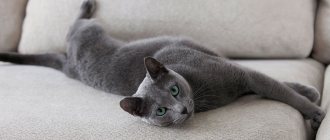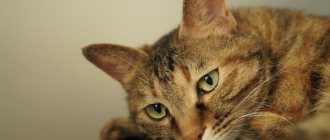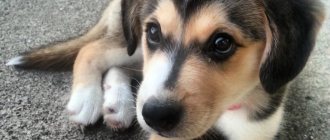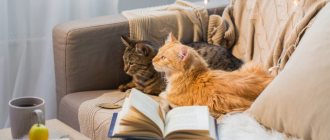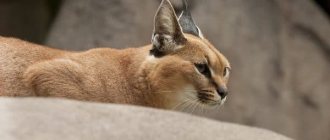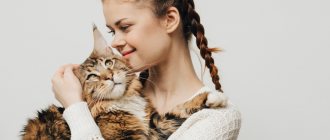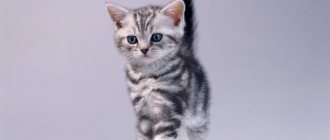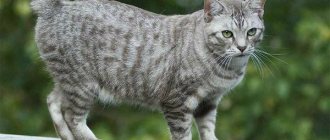It was much easier for cats to hide in the grass, branches of trees and bushes, having intricate patterns on their bodies, than to have a beautiful, even, monochromatic color.
Many breeds have color options in which stripes are normal, but we can highlight the 10 most striped cat breeds, in which monochromaticity is rather exclusive, but stripes are the norm.
Toyger
Of course, this is the most striped of all cat breeds, as can be seen from the name (“toyger” in English - tiger). The toyger is a cat of medium size and build, with superbly developed muscles, an elongated muzzle and clearly visible anus, which is why the shape of the head is similar to an inverted pear, small eyes and ears with rounded tips.
Of course, the main goal of selection is the quality of wool and color as close as possible to tiger. Breeders do everything possible to achieve it. The fur of toygers is short, thick, shiny, the stripes on the coat should be located vertically. The standards allow only one color: brown (black) tabby mackerel, that is, dark stripes on a golden background.
The idea of creating the breed belonged to the American J. Sugden, daughter of J. Mill (the creator of the Bengal breed). It is interesting that the ancestors of Toygers include Bengals - to put it mildly, not tabby cats at all. However, selection by “stretching” Bengal rosettes vertically turned out to be quite successful. The breed has been recognized relatively recently and not yet by all felinological systems.
Genetics of tabby cat color
Tabby color, i.e. The coat pattern, of which the mackerel (tiger, striped) is a subspecies, is caused by the dominant T gene (Tabby), located on chromosome 1B. Of all the mammals living on our planet, it is characteristic only of the cat order.
This color is also called wild, since the very first cats on earth had it. It is characterized by the fact that darker spots and lines are located on a light background.
There are four types of such colors based on the phenotype of the dominant gene (allele):
- Tm - tiger pattern or mackerel, i.e. pure striped;
- Tb - marbled color, classic;
- Ta - agouti, ticking (in Abyssinian cats);
- Spotted Tabby (spotted tabby) - a spotted pattern, this is a polygenic color, a combination of several genes is responsible for it.
Norwegian forest
A large, strong, muscular, very agile cat in a luxurious, very dense coat with water-repellent outer hair covering the back, sides and tail. Breed standards allow many colors, but tabby is one of the most common and, admittedly, the most “suitable” to their harsh appearance.
The ancestors of the Norwegians are feral domestic cats, inhabitants of the forests of Scandinavia for hundreds of years. How they got to those harsh lands is not known for certain. Research has only proven their relationship with Turkish Angoras.
The Norwegian Forest cat is not an old breed, although ideas about its selection appeared back in the 30s of the last century - when it became obvious that the cats of the Scandinavian forests were in danger of extinction. But the breeding program was developed only in the 70s, and was quite successful. Now Norwegians are recognized throughout the world and are the pride of Norwegian breeders (hence the name).
Soukok
These tabby cats are native to Kenya. There is an opinion that these are ordinary domestic cats brought by Europeans, who escaped into the forest and adapted to life in the tropics.
The cat's head is small and wedge-shaped. At the top the skull is almost flat. The ears are round and wide at the base. There are tassels at the ends.
The eyes are large and almond-shaped. Their legs are long, the hind legs are larger than the front ones. When walking, it seems that the cat is crouching. The tail is also long. The body is muscular. The coat is short and lies close to the body. The weight of cats reaches 3-6 kg.
Siberian
Russian felinology also has its own pride - the Siberian cat: powerful, well-built, with pleasant rounded shapes, in a fluffy fur coat with a luxurious collar. Interestingly, with such increased shaggyness, Siberians are one of the most hypoallergenic cats, as they produce less allergen protein than representatives of other breeds. This is a very smart, sociable and active cat that gets along well with the whole family.
Despite the name, “taiga” appearance and numerous stories about the origin of some aboriginal cats - inhabitants of Siberian settlements, the ancestors of the breed were pets and inhabitants of cities in the European part of Russia. It was there that the first Siberian breeders lived, and they selected suitable animals not far from home.
TOP 14 most striking representatives of the striped color
Almost all cats are tabbies, except for breeds that have a solid or solid color. These are Chartreuse, Russian Blue, Nibelung, Bombay cat, Balinese and some others. There are breeds that are bright representatives of the striped color.
Toyger
This breed is essentially a subspecies of the Bengal. For a Bengal cat, the merging of spots into continuous stripes is unacceptable and serves as grounds for disqualification.
The consolidation of this culling factor led to the formation of a new cat variety with a brindle pattern. In English-speaking felinology it is called mackerel.
This strong and energetic pet is no different in personality from the Bengal.
Read more in the article about toygers.
European Shorthair
Celtic cat is the second name of the breed. This naturally occurring variety has a strong, muscular body. He has a calm and friendly character. It is undemanding in maintenance and care.
Siberian cat
Animals with a strong and powerful body and a luxurious fur coat with undercoat are carriers of a very healthy immune system. This natural breed was formed in Siberia over many centuries.
Kurilian Bobtail
A compact, muscular cat, with a slightly arched back, longer hind legs and a short (3 - 8 cm) twisted tail, which, due to its longer fur, has the appearance of a lush pom-pom. The wool is thick, with good water-repellent properties, but a weak undercoat. There are two breeds of Kurbobs, which differ only in the length of their coat. These are sociable, inquisitive, but independent cats, playful and affectionate.
As the name suggests, the breed has some relation to the Kuril Islands. It was there that the ancestors of the Kurbobs lived (and still live). At one time it was assumed that the gene for short-tailed cats living in the Kuril Islands is identical to the gene for Japanese bobtails, a long-existing breed. This version was logical, because Japan is very close. But then it turned out that this was not the case, and cat fans have the opportunity to admire another bred breed.
Cymric
This is another tabby cat with a short tail. The ancestors of this breed come from Maine. They were obtained by crossing a short-tailed cat with a long-haired breed. She is very rare. By the way, the breed is called the Celtic tribe.
The Cymric has a large, rounded head. They have large cheeks and a large chin. The ears are set wide apart and are rounded at the tips. The compact body is well developed. The back of the body is slightly raised (the hind legs of the animal are longer than the front). The tail is missing; in its place there is a small, inconspicuous cartilage.
Cymriki are friendly and playful. The animal does not play pranks: it does not scratch furniture, does not climb curtains, and does not knock over objects. He gets along well with children and never uses his claws. Like the American Bobtail, the Cymric does not tolerate loneliness.
Cornish Rex
This is an elegant, long-legged, graceful cat with an elongated muzzle, large eyes and huge ears. The calling card of the breed is very short curly fur, lying in clear, dense waves. The breed standard allows for all colors, and the striped Cornishes seem to be wearing broadtail fur coats. But their character is not at all similar to that of a sheep - they are very lively, sociable and affectionate cats.
All Cornish cats are descendants of one cat, born in the English county of Cornwall in the middle of the last century. If her owner did not keep rabbits and knew nothing about selection, perhaps there would be no trace of the Cornish. But the unusual fur of her pet’s kitten impressed her, and soon experts learned about the strange cat. The Cornish Rex is the oldest breed of curly-haired cats, of which there are now about a dozen.
As already mentioned, striped color is one of the most common and is allowed by the standards of many breeds, but it is not very common among representatives of some of them. For example, British, Persian or Scottish.
Didn't find what you were looking for? Use the site search form
Feature of striped color
In order for a cat to be tabby, in addition to the tabby gene, its chromosome set must also contain the Agouti ticking gene. In all such cats, each hair is colored in several dark and light shades, arranged in alternating patterns. Visually, this is perceived as lines and spots on the coat.
All ginger cats must have a striped pattern. The red color gene O, linked to the male chromosome X, suppresses the action of the recessive non-Agouti gene.
The tabby pattern can be tortoiseshell (tortie) cats and color-point animals.
Recent scientific research conducted by the famous geneticist Stephen O'Brien has led to the conclusion that the dominant T gene and the cat's immune system are related.
“A tabby is not a simple set of stripes and spots, it plays a more important role in a cat’s body” - this statement by the scientist formed the basis for his study of the relationship between tabby and animal immunity at the Scientific Center for Genomic Bioinformatics in St. Petersburg.
A distinctive feature of tabby cats is the letter “M” on their forehead. There is a biblical legend that it means the name of the Virgin Mary, since the mother of Jesus Christ stroked the head of the kitten lying next to her in the stable of Bethlehem on the night of the birth of the son of God.
Muslims believe that this is the first letter of the name of the Prophet Muhammad, since he loved cats very much.
Care Tips
Whatever cat you decide to buy, it is important not to forget that all pets require care - we are responsible for those we have tamed.
- Carry out water procedures as needed (less often for long-haired dogs, more often for hairless ones).
- Comb your pet's hair, paying special attention during the molting period.
- Create a balanced diet.
- Allow the cats to run, take them for a walk.
- Regularly check with your veterinarian and get the necessary vaccines.
Following these simple rules will allow you to enjoy the company of your furry friend without unnecessary hassle.
Maine Coon
This breed has probably gained the greatest popularity among all cats around the world. Its homeland is North America, Maine. Only large, hardy animals with thick undercoat and thick fur can survive the cold winters of this area.
The Maine Coon's body is muscular, and the cat itself is large. The head is medium size, square in shape. The ears are large, pointed, wide at the base. Paws of medium length. The tail is long, fluffy, and should reach the level of the shoulder blades. The coat is soft, dense, and there is a collar around the neck (however, not always). The color can be any, including striped.
Their character is soft and affectionate. They become very attached to their owner. They lead an active lifestyle and do not require special attention to themselves. Maine Coons do not like to be held. They prefer to just be next to the owner, watching everything that happens.
Asian tabby
The breed was bred in 1980. To do this, they crossed a Burmese chinchilla and a Persian cat. The name suggests that the cat is part of a group of five Asian breeds. Fortunately, the Asian tabby has not inherited any health problems from its Persian ancestors. They are quite strong and hardy, and have every chance of living a long life by cat standards - up to 20 years. The tabby “inherited” received an unusual color, beautiful almond-shaped eyes and an unusually shaped muzzle.
Cats of this breed quickly become attached to their owners, but at the same time they are unobtrusive. If you're in the mood, she'll happily purr on your lap, but she won't be the first to insist on it. Asian tabbies are smart cats. They quickly understand what is required of them . Therefore, problems with education usually do not arise.
The Asian tabby has several types of colors, but the most popular is gray with stripes. Also a distinctive feature is the ticked hairs (at the tip of the hair it has a different color), which creates a very interesting pattern on the coat.
Classic (or traditional)
This type of tabby color in domestic cats is characterized by the presence of narrow stripes that are located along the pet’s spine. It is important to note that usually the stripe in the center is a darker shade, while the stripes on the sides are noticeably lighter. In addition, such animals have a pattern on the sides of the body. This pattern can be painted black, brown or even gray.
